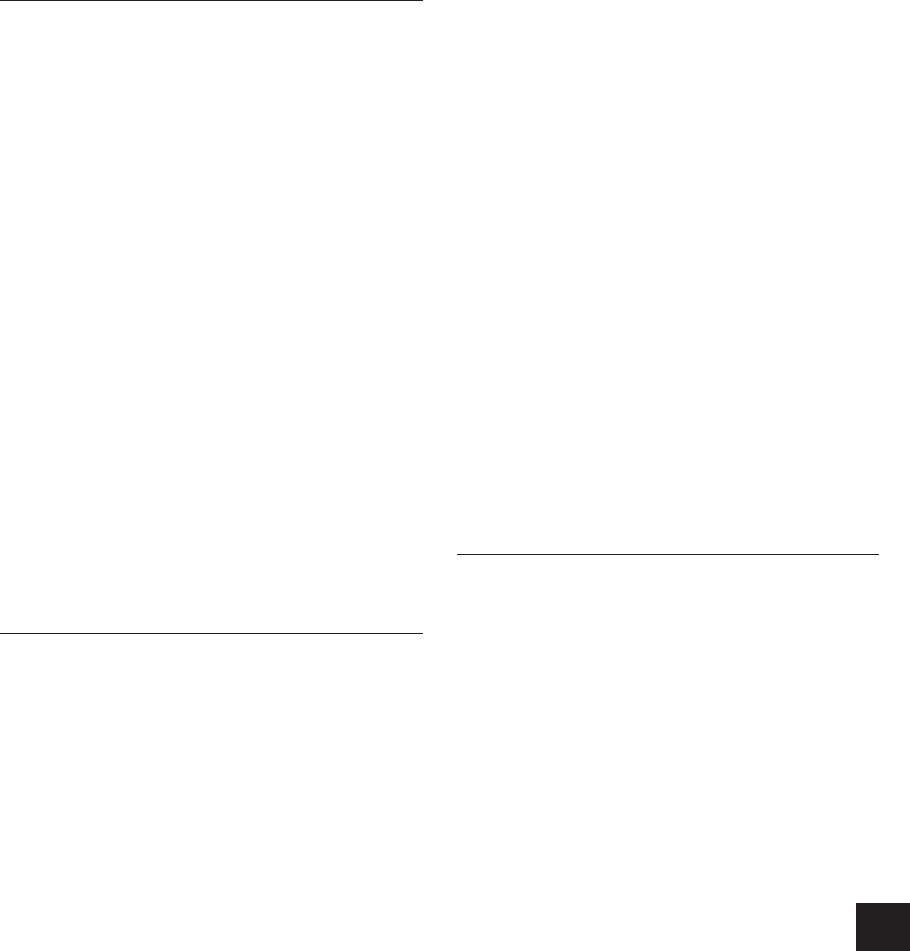
Reference Information
71
CAT-5 Ethernet cable
The Ethernet cable is a cable that actually connects
components that comprise the network. There are straight
type and cross type Ethernet cables.
r
Use a shielded CAT-5 Ethernet cable (straight-type) to
connect the unit to your home network.
Consult your cable store for details of Ethernet cable.
Network server
(When PC etc./network server is used)
Component that stores music files and provides those files
at the time of playback.
r
Requirements for use with this unit depend on the
component that is used as a network server.
r
Conditions for pleasant playback of music files on
the unit depend on the using network server (PC
performance). See instruction manuals of using
components.
Modem (when Internet radio is used)
Device that connects home network (LAN) and Internet
There are many kinds of modems depending on the forms
of Internet connection.
In addition, when connecting to the Internet, it is required
to conclude an agreement with a company that provides
Internet connection service, called ISP (Internet Service
Provider).
Use a modem that is recommended by your ISP company
for the Internet connection.
There are some devices that have both router and modem
functions.
Within above network components, prepare a router,
Ethernet cable, and network server when the NET function
"network server" is used.
For enjoying the NET function "Internet radio," it is
necessary to use the router, Ethernet cable, and modem
(and agreement with ISP).
Server Requirements
Server playback
This unit can play digital music files stored on a PC or
media server and supports the following technologies:
r
Windows Media Player 11
r
Windows Media Player 12
r
DLNA-certified media server
The network server must be connected to the same
network as this unit.
Up to 20,000 folders can be displayed, and folders may be
nested up to 16 levels deep.
Note: Depending on the media server, the unit may not recognize it,
or may not be able to play its music files.
Remote playback
Remote playback is the function that enables this unit to
play music files saved in different components by operating
the DLNA-compliant controller component and PC in the
home network.
r
Windows Media Player 12
r
DLNA-certified (within DLNA Interoperability Guidelines
version 1.5) media server or controller component.
½
The setting varies depending on the media server or controller
components. Refer to your components’ instruction manual for details.
If the operating system of your personal PC is Windows 8/
Windows 7, Windows Media Player 12 is already installed.
For more information, see the Microsoft web site.
USB Storage Device Requirements
r
USB Mass Storage Class (but not always guaranteed).
r
FAT16 or FAT32 file system format.
r
If the USB storage device has been partitioned, each
section will be treated as an independent device.
r
Up to 20,000 folders can be displayed, and folders may
be nested up to 16 levels deep.
r
USB hubs and USB storage devices with hub functions
are not supported. Do not connect these devices to the
unit.
Note:
r
If the media you connect is not supported, the message “No
Storage” will be displayed.
r
Sound files that are protected by copyright cannot be played.
r
When the USB audio player and this unit are connected, the
audio player screen and the screen of the unit may be different.
In addition, control functions of the audio player (classifying and
sorting music files and adding information, etc.) are not available
on this unit.
r
Do not connect a PC to the USB port of the unit. Inputting sound
to the USB port of the unit from a PC is not possible.
r
Media inserted to the USB card reader may not be available in
this function.
r
Some USB storage devices and its contents may require some
time to be read.
r
Depending on the USB storage device, proper reading of the
contents and proper supply of the power supply may not be
possible.
r
Onkyo accepts no responsibility whatsoever for the loss or
damage to data stored on a USB storage device when that
device is used with this unit. We recommend that you back up
your important music files beforehand.
r
Performance of the hard disk that receive power from the USB
port of the unit is not guaranteed.
r
If you connect a USB hard disk drive to the USB port of the unit,
we recommend that you use its AC adapter to power it.
r
When an audio player that are operated with batteries is used,
make sure that the batteries have enough remaining power.
r
USB storage devices with security functions cannot be played.
Supported Audio Formats
r
For server playback and playback from a USB storage
device, this unit supports the following music file formats.
r
Music files of the following formats that can be played
depend on the network server. For example, when using
Windows Media Player 12, not all music files in the PC
can be played. The music files that can be played are the
ones registered to the Windows Media Player 12 library.
r
Variable bit-rate (VBR) files are supported. However,
playback times may not be displayed correctly.
r
This unit supports the gapless playback of the USB
storage device in the following conditions.
When WAV, FLAC and Apple Lossless files are
continuously played back with the same format,
sampling frequency, channels and quantization bit rate.
